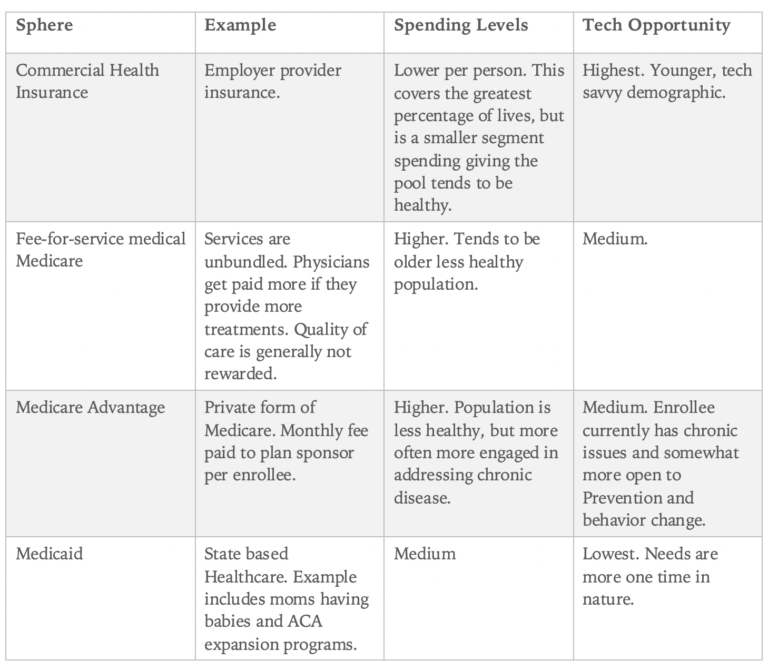Tim Cook commented in a recent interview that their impact on health will be “Apple’s greatest contribution to mankind.” While “greatest contribution” doesn’t necessarily mean “biggest business,” it may mean Apple would pursue a path toward improving primary healthcare by leveraging wearables, AI, and their user-centric software to connect consumers, providers, and payers. We believe the healthcare opportunity is not currently priced into shares of AAPL.
Healthcare & Tech Fundamentals
Healthcare accounts for about 18% of the US GDP. Despite the market size, tech has had a muted impact on healthcare. Several factors play into this – the biggest is how we pay for it, followed by FDA approval hurdles and legacy tech infrastructure. In the US, there are four spheres that cover healthcare expenses: employer-sponsored commercial insurance, fee-for-service traditional Medicare, Medicare Advantage, and Medicaid.

Want to publish your own articles on DistilINFO Publications?
Send us an email, we will get in touch with you.
Healthcare’s Secret: Physicians Have the Relationships with Patients
There’s enough money in healthcare, but at the core of the “how do we pay for it” question is aligning the incentives of payers and providers. The majority of healthcare financial incentives are with the payer – usually a private insurer or government. If the payer saves money, profits go up. The challenge is that the payer does not have direct access to the patient, so it’s difficult to influence behavior to improve wellness. Healthcare’s secret is physicians/providers have the relationship with patients, and relationships influence behavior. The question is, can tech enhance or foster that relationship to be more regular and more productive?
Putting the Provider System at Risk
Over the past 15 years, financial incentives have been slowly shifting to the providers. With “provider risk” the physician takes on the financial risk of care – both costs and outcomes. Instead of billing $150 for a 20-minute office visit, the physician is paid $1,100 a month to manage total care of that patient. This means a physician’s profits increase with better care and healthier patients. Commercial, Medicaid, and FFS Medicare are all experimenting with different incentive models and slowly increasing their respective provider participation, which is still modest overall. As financial incentives shift to providers, physicians will be more willing to pay for consumer tech that influences behavior and provides early warning systems.
Apple’s Healthcare Opportunity
Wearables
Apple’s approach to the Healthcare industry is largely unknown. What we do know is the Apple Watch and eventually AirPods create new ways for consumers to track and manage wellness, notably by tracking heart rate, activity, and heart health. In the future, we expect the company to add biomarkers like blood pressure and hydration. The wearables segment represents a measurable revenue opportunity given it’s small today and foundational to Apple’s healthcare master plan. Wearables (90% of which is Watch and AirPods, 10% Beats) account for 5% of sales today, and we expect that to grow to ~8% of sales in five years.
We believe Watch sales have reached 67m units since the product was released in mid-2015 and estimate 85% of those are still in use, resulting in an active installed base of 57m. That compares with an active iPhone base of just over 900m. Using the iPhone as an addressable market guideline suggests the Watch business could eventually be 15x bigger. That level of Watch adoption is highly unlikely, but we can build a case that the Watch business will eventually be 4x bigger than today, which would imply $35B in annual sales, compared to $8.8B in FY18. Factoring in an asp of $300 yields 115m annual units, up from about 23m at a $375 asp last year.
AirPods are a second opportunity for capturing biomarkers, but adding these features is complicated and likely years away. It’s worth noting the inner ear is an attractive place to gather biomarkers with the ear canal’s thinner skin. Apple has filed a patent outlining the inner ear opportunity.

Source: company reports and Loup Ventures estimates
There’s a Market Today for an Apple Healthcare Subscription
For physicians or any payer who covers healthcare expenses, there’s a market for this now, regardless of what happens with provider risk-sharing models. Apple’s healthcare services opportunity likely lies in harvesting the data from Watch and AirPods, then filtering, analyzing, and making it actionable. AI will be foundational to these services given the volume of data that needs to be processed. The offering would likely start with the consumer paying ~$300 for a Watch that captures heart rate, activity, sleep, temperature, blood pressure and makes the data actionable, then the physician would pay Apple a per month per user fee (~$10).
Date: March 20, 2019
Source: LoupVentures







